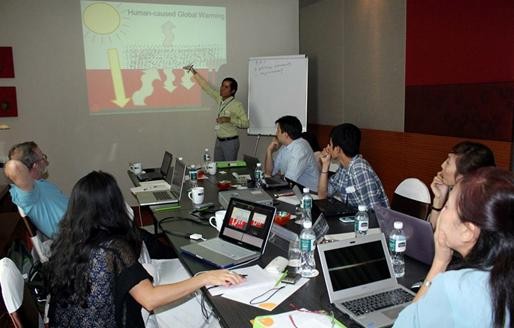
There’s been a change of climate in Cambodian classrooms—brought about by the first climate change course curriculum taught in the country’s universities. With support from USAID, students can now study the impact changing climate will have on Cambodia and the region.
A champion of this new curriculum is Bunleng Se, professor in the Department of Geography and Land Management at the Royal University of Phnom Penh. For many years, he has known his home country is highly vulnerable to the impacts of climate change. He has also known that Cambodia is rapidly losing its forests at a rate of 0.5 percent per year, and that 85 percent of rural populations live near forests.
Se learned that forested areas cover approximately 26 percent of the Asia-Pacific region, providing socio-economic and environmental benefits to communities including forest-related income, carbon storage, biodiversity conservation and watershed protection. Forests in the region are, however, disappearing rapidly due to agricultural expansion, unsustainable logging, urbanization and other pressures. Deforestation and forest degradation are major sources of greenhouse gas emissions in Southeast Asia, and contribute greatly to global climate change.
Over the years, Se shared these facts with his students. But with only a few outdated teaching resources to explain climate change in greater technical detail, his ability to educate and inspire students was limited. Many of his students had heard the phrase “climate change” before, but did not understand what it meant and what it could mean for the future of Cambodia.
“Climate change courses are new to Cambodian universities,” Se said. “People hear climate change being discussed, but they wonder, ‘What does that actually mean?’”
That began to change when Se joined 32 other professors from 12 Southeast Asian and three U.S. universities to create new learning modules and teaching materials and test these resources in universities across the region.
Through the USAID-funded Lowering Emissions in Asia’s Forests program, Se and the other professors developed four climate change modules in the summer of 2013: basic climate change, carbon monitoring and measurement, low emission land use planning, and social and environmental soundness. They are now testing these resources in universities and joining in discussions about further adapting the modules to fit each country’s context and then extend them through other USAID-funded programs.
The curriculum development work also focuses on training professors in more effective ways to present technical information in the classroom. As the professors continue to develop these materials as part of their teaching, USAID’s partners expect climate change knowledge to reach over 4,000 university students over the next two years.
“This opportunity to work with other professors from around the region and from the United States to create a basic climate change module is already having a real impact,” Se said. “I am integrating parts of the module into my courses and I am more confident in my teaching methods and better able to inspire my students to understand, care about, and tackle climate change.”
The Lowering Emissions in Asia's Forests program, which started in 2011 and ends in January 2016, takes a regional approach to strengthening forest management in six core countries: Cambodia, Laos, Malaysia, Papua New Guinea, Thailand and Vietnam. Forest loss and degradation are important factors in global climate change, representing about 15 percent of total global greenhouse gas emissions annually. Roughly half of this amount comes from deforestation and forest degradation in Asia.







Comment
Make a general inquiry or suggest an improvement.